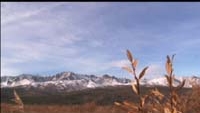Tanacross language
Tanacross (also Transitional Tanana) is an endangered Athabaskan language spoken by fewer than 60 people in eastern Interior Alaska.In addition several speakers now reside in the nearest commercial center of Fairbanks, located two hundred miles downstream from Tanacross village and accessible by all-weather highway.Tanacross is the ancestral language of the Mansfield-Kechumstuk and Healy Lake-Joseph Village bands of Tanana Athabaskan people, whose ancestral territory encompassed an area bounded by the Goodpaster River to the west, the Alaska Range to the south, the Fortymile and Tok rivers to the east, and the Yukon Uplands to the north.The first extensive ethnographic research in the area was conducted by McKennan in 1929-30, who excludes Tanacross from his map of what he labels as the Upper Tanana region (1959: 16).The rapids referred to by McKennan serve as a barrier to salmon migration and remove a major incentive for river settlement (de Laguna & McClellan 1960).And at least until the construction of the Alaska Highway in 1942, foot and sled travel between Healy Lake, Mansfield and Kechumstuk was extremely common (Ellen Demit, p.c.).Tanacross and Upper Tanana share a high degree of mutual intelligibility, though the tonal patterns (with the exception of the Tetlin dialect, which is apparently toneless) are reversed.A second dialect of Tanacross is spoken by the Healy Lake-Joseph Village bands at Healy Lake (Mendees Cheeg) and Dot Lake (Kelt’aaddh Menn’) to the west, and formerly at Joseph Village, and is linguistically distinguished by the retention of schwa suffixes.Although most children have passive understanding of simple commands and phrases, most fluent speakers of Tanacross are at least fifty years old.Thus, the practical orthography does not distinguish short e from ə. Vowels may be marked for high (á), rising (ǎ), falling (â) or extra-high (á́) tone.One of the distinguishing features of Tanacross is the presence of so-called semi-voiced fricatives, a unique type of segment which appear to begin voiceless and transition to fully voiced.However, Tanacross is distinguished most dramatically from neighboring languages by the development of Proto-Athabaskan (PA) constricted vowels into high tone.This area would include all groups which have regularly participated in potlatch ceremonies with Tanacross, including the Upper Tanana of Tetlin, Northway and Beaver Creek; the Han of the vicinity of Eagle, Alaska and Dawson City, Yukon; and the Mentasta Ahtna of the Mentasta area.In addition to the strictly linguistic resources to be discussed below, Isaac (1988) and Simeone (1995) provide important cultural background on the Tanacross community.Simeone's book is an ethnographic sketch written by an Episcopal lay worker who spent much of the 1970s living in Tanacross village.In the late 1970s and early 1980s, Jeff Leer compiled further notes on grammatical paradigms[17] and phonological features,[18][19] including the three-way fricative voicing contrast.[20] Ron Scollon transcribed and translated a collection of texts from speaker Gaither Paul using a revised orthography which indicates tone.[21] Kari has compiled a preliminary stem list based on information collected from several speakers in the 1980s, but tone is not marked.

Tanacross, AlaskaUnited StatesAlaskaTanana RiverTananaLanguage familyDené–YeniseianNa-DenéAthabaskanNorthern AthabaskanWriting systemLatin scriptISO 639-3GlottologUNESCOAtlas of the World's Languages in DangerUnicodeendangeredAthabaskan languageInterior AlaskaethnolinguisticTanacrossAlaska HighwayFairbanksHealy LakeTanana AthabaskanGoodpaster RiverAlaska RangeFortymileUplandstrading postsTanana CrossinglinguonymsUpper TananariverinesalmonHoijerlinguonymLower TananaKraussAhtna languageSlana RiverSalchaSalcha RiverNenanaDot LakesuffixesfluentAlaska Athabaskan languageTanacross villagelanguage revitalizationWhitehorseNative Language teachingUniversity of Alaskatone languagesGwichʼinCentralvowelsorthographyreduced vowelconsonantsaffricatesunaspiratedvoicedLabialAlveolarDentalLateralPalatalGlottalPlosiveAffricatet͡sʰt͡θʰt͡ɬʰt͡ʃʰt͡sʼt͡θʼt͡ɬʼt͡ʃʼFricativeSonorantfricativesallophonicAthabaskan family of languagesNorthern groupPacific CoastApachean groupNavajoTolowaCanadadialectologyphonologymorphologypotlatchTetlinNorthwayBeaver CreekEagle, AlaskaDawson Citymultilingualismsocio-linguisticoral historyethnographicPrince William Soundgrammatical paradigmsphonological featureslexicalAlaska Native Language ArchiveAlaska Native Language CenterGary HoltonNabesnaAthabaskan languagesNorthernDenaʼinaDeg HitʼanHolikachukKoyukonNorthern TutchoneSouthern TutchoneUpper KuskokwimDene SulineDogribDunnezaSekaniSlavey